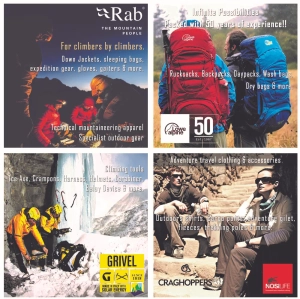To rejuvenate the locked down wanderers’ soul
A Prescription of 10 Mountaineering Books by Anindya Mukherjee
My uncle Sujal Mukherjee was one of the first generation mountaineers of West Bengal. His tryst with the Himalaya started in 1961 till he breathed his last in 1994. Instrumental as his passion for the craft was for my own introduction to the mountains, it was his prodigious appetite for mountain literature that showed me the seminal steps to enrich whatever I had begun to learn and extend whatever visage of the art and tradition of mountaineering I had begun to conceive.

There is a wealth of literature about or inspired by mountains and it's easy to see why. One only has to think of a mountain and powerful adjectives simply tumble from your fingertips: solitary, ancient, vast, meditative, and God-like. As rivers often represent the flow of life, the mountains too are a handy metaphor for the insignificance of man or even a looming reminder that ours is a planet built on nature's magnificent brutality.

Below is a list of ten books (in no particular order). They remain as my all time favorite books of mountaineering literature. If classics can be defined in terms of their lasting freshness, then the following books are definitely ‘classics’ of the mountain literature. I strongly recommend them to both our avid mountain wanderers and armchair mountaineers alike.
1. Kamet Conquered - Frank Smythe
Frank Smythe’s fascinating book Kamet Conquered tells of his successful bid to make the first ascent of Kamet (7,756 metres) in 1931.Through Smythe, an experienced high-altitude mountaineer, the reader experiences all the tension, fatigue, discomfort and struggle of a major expedition but is also able to enjoy the sublime descriptions of nature at its wildest and most beautiful. Smythe is a keen observer of light, cloud and colour and his spiritual prose conjures up a palpable sense of the Himalaya.

There is a rich sense of history within these pages; the book is very much of its time. However, the sometimes harsh colonial attitudes do not eclipse the genuine respect Smythe has for his Indian and Sherpa companions, nor what these remarkable men achieved. Through this journey, we are led from the dank, steamy foothills of the Himalaya, to its harsh and inhospitable peaks as Smythe and his team push themselves to their limits.
Frank Sydney Smythe was an extremely gifted and well-traveled mountaineer who wrote many very popular books about mountaineering during the first half of the last century. He achieved prominence in mountaineering circles following two impressive seasons in the Alps in 1927 and 1928. He subsequently climbed extensively in the Himalayas.
(Source: Chessler Books & Google Books)
2. Annapurna: First Conquest of an 8000-meter Peak - Maurice Herzog
Annapurna: First Conquest of an 8000-meter Peak (1951) is a book by French climber Maurice Herzog, leader of the 1950 French Annapurna expedition, the first expedition in history to summit and return from an 8000+ meter mountain, Annapurna in the Himalaya. Annapurna was the first mountain over 8,000m to be climbed.

In late 1950, Maurice Herzog lay in the American hospital at Neuilly-sur-Seine, on the outskirts of Paris, dictating what would become the bestselling mountaineering book of all time, Annapurna, published the following year. The effort was emotionally exacting, as he revisited every twist and agonising turn of one of the most important Himalayan expeditions in the sport's history. With breathtaking courage and grit manifest on every page, Annapurna is one of the greatest adventure stories ever told. It is considered a classic of mountaineering literature and perhaps the most influential climbing book ever written.
(Source: The Guardian & Wikipedia)
3. The White Spider - Heinrich Harrer
The White Spider (1959; with chapters added in 1964; original title: Die Weisse Spinne) is a book written by Heinrich Harrer that describes the first successful ascent of the Eiger Nordwand (Eiger north face), a mountain in the Berner Oberland of the Swiss Alps. Not one for the faint-hearted, the action of this book includes avalanches, rockfall and brutal storms abound in Harrer’s record of a significant period of mountaineering history.

From 1935-1958, personal ambitions and national rivalries funnelled climbers from across Europe to take up ropes, crampons and ice axes in pursuit of a glorious new conquest: the first ascent of the North Face. Teamwork, competition, tactical retreats, heroic rescues and desperate tragedies unfold on this unforgiving, icy face. The White Spider takes readers to a place where few can follow. Harrer illuminates the profound lessons that are learned on the severe edges of our world.
(Source: The Guardian & Wikipedia)
4. The Shining Mountain - Peter Boardman (with material by Joe Tasker)
‘It’s a preposterous plan. Still, if you do get up it, it’ll be the hardest thing that’s been done in the Himalaya.’ - So spoke Chris Bonington when Peter Boardman and Joe Tasker presented him with their plan to tackle the unclimbed West Wall of Changabang – the Shining Mountain – in 1976.

Tasker contributes a second voice throughout this story, which includes details of the inevitable tensions on such an expedition as well as a record of the moment of joy upon reaching the summit ridge against all odds. The Shining Mountain, is one of the outstanding works of mountaineering literature, and won the 1979 John Llewellyn Rhys Prize for literature.
(Source: V Publishing & Wikipedia)
5. Round Kangchenjunga – Douglas Freshfield
This work by Douglas William Freshfield (1845-1934), enhanced by photographs of the great mountain photographer Vittorio Sella (1859-1943), is considered by many to be one of the best of the classic books on mountaineering. At the time the trip was taken, although the team had the authorization of the ruler of Sikkim, they had none by Nepal as it was then a closed kingdom. The expedition lasted seven weeks, and when they descended into Nepal, the first villagers they met...were astonished to learn that this tattered group had come down from the north. This work has been selected by scholars as being culturally important and is part of the knowledge base of civilization as we know it.

Excerpt: It is of course impossible to go up and down feet without some climbing, in the popular sense of that word. But in the technical Alpine sense we had far too little mountaineering for my taste. Rope and ice-axe played but a very subordinate part in our journey. This was our mis fortune rather than our fault. The tremendous rainstorm of September 1899, after devastating Darjeeling and its tea-gardens, swept across Kangchenjunga into Tibet in the form of a premature snowfall, lowering the snow-level nearly 4000 feet and practically closing the highest region.
(Source: Forgotten Books & Google Books)
6. Nanda Devi: Exploration and Ascent - A Compilation of the Two Mountain Exploration Books, Nanda Devi & the Ascent of Nanda Devi - Eric Shipton & H.W.Tilman
Two classic mountain exploration books, Nanda Devi and The Ascent of Nanda Devi are compiled, along with further accounts by Shipton and Tilman, two of the best-known names in mountaineering.

The wide-ranging expedition of Eric Shipton and H.W. Tilman in the Garhwal Himalaya in 1934 is regarded as the epitome of adventurous mountaineering. With their Sherpa companions they solved the problem of access to the Nanda Devi Sanctuary, crossed difficult cols, made first ascents, and explored remote, uninhabited valleys. These adventures are recounted in Shipton's wonderfully vivid Nanda Devi, one of the most inspirational mountain-travel books ever written. Once access to Nanda Devi was found, it was only a matter of time before a first ascent attempt was mounted. In 1936 Tilman joined an American and British expedition and tells the tale of their successful climb in his restrained, witty account, The Ascent of Nanda Devi. This compilation of these classic tales is concluded with further accounts by Shipton of his subsequent surveying expeditions in and around the Sanctuary, which served to mitigate his regret in missing the ascent of Nanda Devi (he was on Everest at the time.) Together, the writing of these two mountaineering legends creates a fascinating adventure tale.
(Source: Good Reads & Indian Mountaineering Foundation)
7. Everest the West Ridge - Thomas F. Hornbein
In 1963, Jim Whittaker became the first American to summit Everest via the South Col route. Roughly two weeks after Whittaker's achievement, Tom Hornbein and Willi Unsoeld, fellow American mountaineers on the same expedition, became the first climbers ever to summit the world's highest peak via the dangerous and forbidding West Ridge--a route on which only a handful of climbers have since succeeded.

Hornbein’s book is devoid of overblown heroics. Everest is not "conquered." The book also avoids the overly intimate, every-rivalry-recorded style of more modern books (e.g. awful accounts of Unsoeld's subsequent expedition to Nanda Devi). In this book, climbers' interactions get discussed without psychobabble. (Source: Google Books)
“This is the story of one of the greatest achievements in American mountaineering history: Willi Unsoeld and Tom Hornbein climbing to the top of the world from Everest's West Ridge, descending from the South Col and bivouacking at 28,000-feet. It is a great story of determination, passion and friendship.... One of my favorite things about this book is the many outstanding photographs paired with quotes about mountains”.--Katie Sauter, Library Director ‘American Alpine Club Library’
8. Annapurna South Face – Chris Bonington
In 1970 Chris Bonington and his now-legendary team of mountaineers successfully battled up a seemingly impregnable face in The Himalayas. It was a magnificient triumph for mountaineering and good teamwork. Annapurna South Face tells how it was done. 12,000 feet of steep rock and ice leading to a 26, 454-ft. summit

As serious armchair climbers will tell you, Annapurna South Face is better than all but a handful of equally gripping classics. One could also argue that all that has happened in the big mountains in the past 30 years has come out of this expedition and out of this book. Bonington and his team—most of whom subsequently died in the mountains—represented a kind of "greatest generation" of modern mountaineers. They pioneered a new, bolder approach to high altitude climbing, and this book is about how they hit the big time.(Source: Goodreads)
"He writes as well as he climbs' - Times Literary Supplement
"This is a very good book indeed, Exciting, psychologically Illuminating and honest, and I read it entranced'. - C.P. Snow in the Financial times
9. No Picnic on Mount Kenya- Felice Benuzzi
No Picnic on Mount Kenya (Italian: Fuga sul Kenya) by Felice Benuzzi is a mountaineering classic recounting the 1943 attempt of three escaped Italian prisoners of war to reach the summit of Mount Kenya. It was first published in 1946 in English and 1947 in Italian. The 1994 film The Ascent is based on this book. Rick Ridgeway sums it up, “This contrast of the freedom of the mountains against the oppression of man is the leitmotif of Benuzzi's book.

Perhaps more than any climbing story, No Picnic on Mount Kenya captures that strong underpinning of revolt common to most mountaineers. The men and women I know drawn to the hills are mavericks whose principal loyalty is to the individual's right to take his own risks and discover his own truths, and as much as anyone, Benuzzi applauds that right and condemns those who might curtail it.”(Source: Wikipedia)
'A tale worth reading ... Mr Benuzzi's paradoxical mixture of pride and self-mocking humility is attractive; his courage is amazing; his story dramatic' - New York Times.
‘More electrifying than anything a person with a nose for real adventure could hope to read’ - Piero Melati, Repubblica
10. The Ascent of Rum Doodle - W. E. Bowman
"The Ascent of Rum Doodle is a short 1956 novel by W. E. Bowman (1911–1985). It is a parody of the non-fictional chronicles of mountaineering expeditions (notably H. W. Tilman's account of the ascent of Nanda Devi and Maurice Herzog's book Annapurna chronicling the first ascent of Annapurna in Nepal) that were popular during the 1950s, as many of the world's highest peaks were climbed for the first time. A new edition was released in 2001 with an introduction by the contemporary humorist Bill Bryson.

Bowman also offers a couple of predictable chapters as the group goes in circles and then proceeds to climb the wrong mountain, and he spends an inordinate amount of prose on their suffering at the hands of the sadistic cook, a Yogistani named Pong. Bowman manages to sustain a very thin conceit for a large number of chapters, although the silliness can at times be sophomoric. He redeems himself somewhat with an amusing "surprise" ending that features the 3,000 Yogistani porters involved in the expedition, and overall he proves himself to be an entertaining humorist who has much to offer for readers who like their outdoor humor dripping with understated British irony. It has been critically well received. Though a parody, it has become one of the most famous and celebrated books of mountaineering literature.
(Source: Publishers Weekly & Wikipedia)
If you’re looking to buy vintage edition or autographed copy of these books then 'Chessler Books' & 'Abe Books' have some rare finds. Happy reading & collecting!
About the Author

An active mountaineer and adventurer with a penchant for exploration, Anindya Mukherjee has been on 57 mountaineering expeditions across the Indian Himalaya (including mountains like Kamet, Shivling, Satopanth and Nanda Devi East).


















